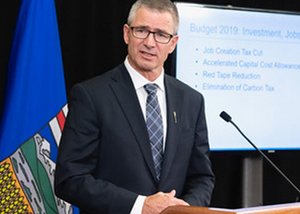Budget 2019: A review
Kimberley Burfoot, Executive Director, Alberta Motor Transport Association
On Oct. 24 2019, Alberta’s United Conservative Party (UPC) released Budget 2019: A plan for jobs and the economy.
Designed to reign in the province’s previous nine years of deficits, the overriding theme surrounding the budget release was that Alberta needs to live within its means.
Certainly, the UCP has been very transparent these past months preparing us to expect that this will be a budget with deep spending cuts. With this plan, the UCP expects a balanced budget by the end of 2023.
The Alberta Motor Transport Association (AMTA) has met with the Ministry of Finance and the Ministry of Transportation to better understand impacts the highway transportation sector can expect over the next four years:
The elimination of the Carbon Tax has been maintained. In its place, a Technology Innovation and Emissions Reduction (TIER) program will be put in place for large industrial emitters. About one-third of the revenues from this fund will go towards paying down the deficit and a campaign touting Alberta’s environmentally responsible oil sector. The remainder will go to innovation and technology programs; carbon capture and storage capital projects and a coal workforce transition. The commercial transportation industry is not expected to be required to pay into this fund.
A reduction in the corporate tax rate from 12 per cent to eight per cent in 2022, and an enhanced Capital Cost Allowance to provide investment incentive has been announced. These changes will make Alberta’s tax rates 30 per cent less than the next lowest province, and a lower combined federal-provincial tax rate than 44 U.S. states — making Alberta one of the most competitive places in North America to attract investment.
A 16 per cent reduction in the Ministry of Transportation’s annual maintenance operating expenses has also been announced. Alberta Transportation maintains 64,000 lane kilometers of road through third-party maintenance contractors. The ministry expects this reduction will be achieved through cuts to non-safety related maintenance, including:
Reduction or elimination of roadside and ditch mowing, where sight-lines are not impacted
Delaying non-critical repair of potholes and crack sealing
Winter snow removal will not be affected, nor will upgrades which extend the service life of roads.
Mandatory Entry Level Commercial Training (MELT) and the Pre-Entry Program for New National Safety Code Carriers will be unaffected. What may be affected later is the Driver Examiner program, which moved examinations from private to a program of the Government of Alberta in March 2019. This program is currently under review and we are not aware of any timeline for its completion.
The Ministry of Transportation will reduce administrative costs by consolidating and reducing operations in Traffic Safety Services and limiting Transportation Safety Board discretionary spending.
Traffic Safety public education initiatives will have its communications budget eliminated, utilizing no-cost social media tactics in order to engage with roadway users.
Recently closed rest stops in Northern Alberta will remain closed as a cost-savings measure. This closure will be reviewed annually.
According to the 2019 Provincial Construction Program, other rest stop solutions are in the works. Over the next four years, design work will commence for Safety Rest Areas (SRAs) northbound near Bowden and southbound near Wolf Creek. Construction will begin or continue at the SRAs on Highway 36 at the town of Vauxhall, and northwest of Highways 2 and 42.
Maintaining the funding announcement made in September for Women Building Futures, which includes a successful and popular Professional Class 1 Driver program.
The Capital Plan includes funding for these roads and bridges projects:
-
City of Edmonton – 50th Street – $14M
-
Deerfoot Trail Upgrades (Calgary) – $110M
-
Edmonton/Calgary Ring Roads – $1.873M
-
Gaetz Avenue/Taylor Drive Interchange (Red Deer) – $5M
-
Highway 43 Bypass (Grande Prairie) – $8M
-
Highway 19 (east and west ends) – $28M
-
Highway 1A upgrade (Stoney First Nation) – $27M
-
Highway 63 twinning (Grassland to Fort McMurray) – $49M
-
Other highway twinning, widening and expansion – $597M
-
P3 Ring Road rehabilitation – $28M
-
Peace River bridge – $56M
The current deficit is not sustainable, and money spent on interest today could be used for important transportation infrastructure projects tomorrow. Alberta’s current debt problem currently results in interest payments which cost enough that we could pave the QE2 from Calgary to Red Deer every month.
The AMTA recognizes the importance of working towards a balanced budget, and we agree with an approach to spending cuts that maintains a focus on protecting safety. We are looking forward to working with Alberta Transportation to ensure that happens.
We also look forward to working with Alberta Transportation on critical transportation sector issues, like adequate rest stops and other highway improvements which were not fully addressed in this budget.



